From the NYT:
In Newark, a New Chapter Unfolding
In Newark’s Central Ward, not far from the site of the 1967 riots, a market-rate rental building opened earlier this year with 152 apartments and its name, 24 Jones, emblazoned in cheerful orange lettering on the blocky, colorful facade. Promotional materials invite prospective tenants to “come to a place where everything is possible.”
What, exactly, is possible in Newark? That is the question driving this next chapter of the city’s history. With about $2 billion in commercial and residential development underway, 1,500 units of housing are under construction and another 4,000 are planned, according to the city’s department of economic and housing development. Corporate dollars have poured into the city in recent years. Since 2008, Goldman Sachs has invested $500 million in the city, and Prudential Financial, which is based in Newark, has invested $368 million.
Vacant lots are being redeveloped, like the 11-acre parcel that now houses 24 Jones, which is the residential piece of a $94 million project called Springfield Avenue Marketplace that also includes a ShopRite and other stores. Forsaken buildings are being renovated, such as the 1901 Hahne & Company department store, which had been a grand shopping destination until it shut in the 1980s, languishing downtown ever since, a hulking testament to how far the city had fallen. By next year, a $174 million restoration will transform the structure into 160 apartments, a cultural center for Rutgers University and a Whole Foods Market.
“This is the largest city in the state and for too long it’s been hamstrung by people’s discomfort with its reputation,” said Jonathan M. Cortell, the vice president of development for L & M Development Partners, which owns the Hahne’s building with other partners. “And now, maybe it’s premature to start calling it a rising star, but there’s positive action happening here.”
…
But Newark cannot simply build its problems away. Nearly a third of the city’s residents live in poverty, according to census data, while crime is high and many of its schools are failing. One of the city’s biggest assets — available land — is also a liability, as there is no shortage of vacant lots and abandoned parcels across the city. The city also faces redevelopment challenges that are different from those in neighboring cities like Harrison, Jersey City and Hoboken, which have tied their fortunes to Manhattan by enticing New York commuters with promises of cheaper housing and a quick ride to the city.“Newark’s not trying to be the next Brooklyn, or the next Jersey City,” said Baye Adofo-Wilson, Newark’s Deputy Mayor for Economic and Housing Development, adding, “We have our own richness and our own culture here that isn’t just an expansion of Wall Street, but really an expansion of Newark and an expansion of New Jersey.”

